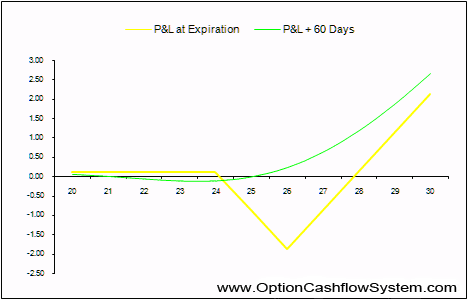Ratio Backspreads by
Post on: 16 Апрель, 2015 No Comment

Ratio Backspread — Definition
Credit volatile options trading strategy that opens up one leg for unlimited profit through selling a smaller amount of in the money options against the purchase of at the money or out of the money options of the same type.
Ratio Backspread — Introduction
Find Out How My Students Make Over 87% Profit Monthly, Confidently, Trading Options In The US Market!
How are Ratio Backspreads Different from Regular Backspreads?
First of all, Ratio Backspreads are exactly like the regular backspreads in the sense that both are designed to profit when the underlying stock goes up or down strongly. The difference between Ratio Backspreads is that ratio backspreads has the advantage of being the only credit backspreads that are capable of unlimited options trading profit in a single direction! No regular credit backspreads are capable of unlimited profits either way. Lets look at the risk graph of a Ratio Backspread ( call ratio backspread ) and a regular credit backspread ( Short Butterfly Spread ) below:
As you can see above, the Short Butterfly Spread has limited profit no matter if the stock goes up or down but the Call Ratio Backspread has unlimited profit if the stock went upwards and a limited profit if the stock went downwards. This is the main difference between Ratio Backspreads and regular credit backspreads. In fact, ratio backspreads are backspreads with a directional bias. This directional bias is what sets ratio backspreads apart from the regular backspreads. Ratio backspreads are truly examples of the extreme flexibility and versatility that you can only get through options trading.
When will you use Ratio Backspreads
You should use Ratio Backspreads when you are of the opinion that a stock might breakout strongly to topside or downside and that there is a higher chance it will break out in a certain direction and continue in that direction. For instance, if you are of the opinion that AAPL would stage a breakout soon and the breakout would probably be to upside. You want to have unlimited profit to ride the upside profits should that happen but you also want to make a limited profit if AAPL should break out to downside instead. In this case, you would use a Call Ratio Backspread.
Ratio Backspread Strategies
Here is a list of Ratio Backspreads:
Call Ratio Backspread — Ratio backspread using call options only with unlimited profit to upside. It involves buying more at the money call options than in the money call options are shorted.
Put Ratio Backspread — Ratio backspread using put options only with unlimited profit to downside. It involves buying more at the money put options than in the money put options are shorted.
Call Diagonal Ratio Backspread — Similar to the Call Ratio Backspread except that long term call options are bought and nearer term call options are shorted. This allows the stock more time to breakout. It is also classified as a form of Diagonal Ratio Spread.
Put Diagonal Ratio Backspread — Similar to the Put Ratio Backspread except that long term put options are bought and nearer term put options are shorted. This also allows the stock more time to breakout. It is also classified as a form of Diagonal Ratio Spread.
Advantages of Ratio Backspreads
Ratio backspreads are all credit spreads. which means that you receive money for putting on the position, money which can be reinvested elsewhere during the life of the position. More than being just credit spreads, Ratio Backspreads are the only credit backspreads with a directional bias where one leg is opened for unlimited profits. This makes ratio backspreads perfect for speculating on a breakout that isn’t just 50/50.
Drawbacks of Ratio Backspreads
Even though Ratio Backspreads offers the unique ability of profiting from both up and down moves, its nemesis comes in the form of stock remaining stagnant. As Ratio Backspreads are typically put on ahead or during periods of high volatility resulting in high option premiums, potential losses should the underlying stock remain stagnant could be very significant due to time decay and ditch in implied volatility. what we call a volatility crunch in options trading. Even though stocks rarely stay stagnant over significant periods of time, Murphy’s Law does apply and Ratio Backspreaders need to be aware and cater for such potential options trading losses. Fortunately, maximum potential losses can be precisely calculated for all Ratio Backspreads. As such, you would be able to determine in advance if the potential reward justifies the risk involved.














